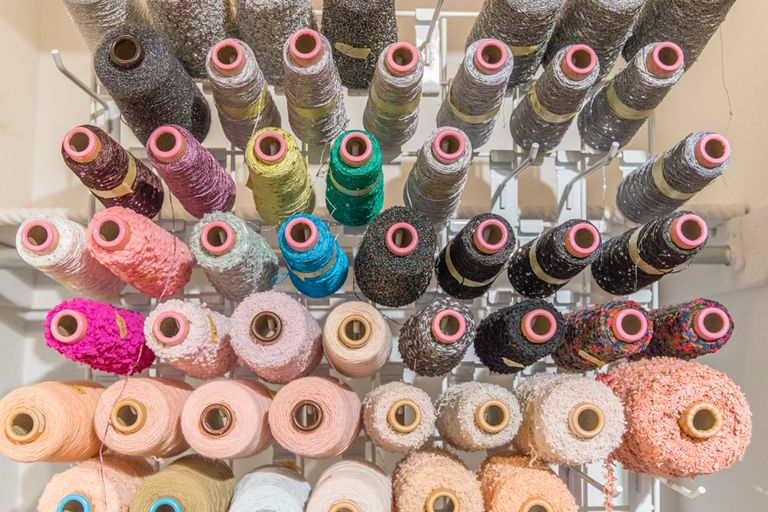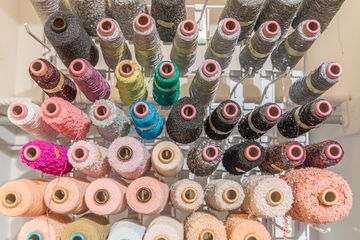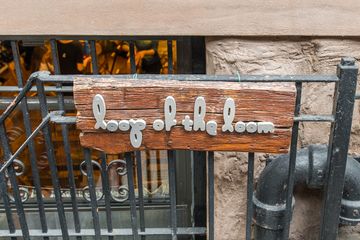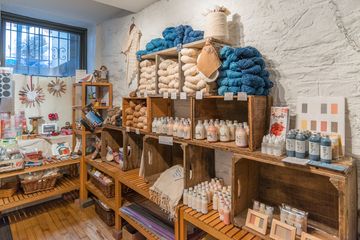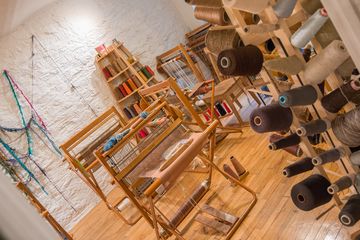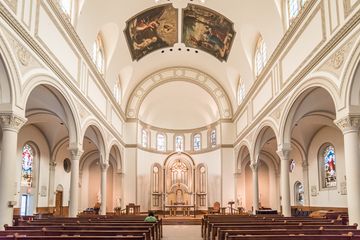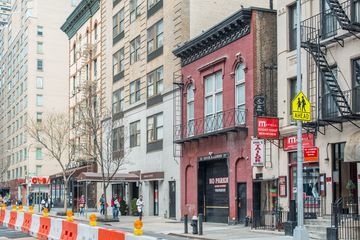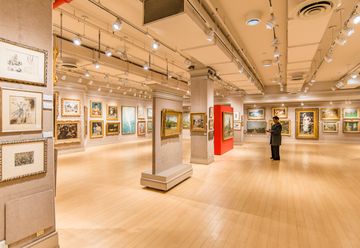I would not have guessed, walking through the room hung with sparkly princess dresses and pink china, that Judy Famigletti used to be a hockey mom. The owner of Let's Dress Up, an event center for little girls, told me that she has two sons who both played ice hockey through college. She would go with them to their different games and formed her own business while traveling: she designed sports-themed Christmas ornaments, which developed into a broader home accessories business. While she greatly enjoyed painting, sewing, and decorating, most of Judy's creative power was directed towards sports and practicality. She had no use for frills and sparkles. Once her sons were grown, Judy moved to the city and set off on a new path. She knew that she wanted to have her own business that involved home decorating and that she wanted to work with little girls, since she was already very familiar with the world of boys. She reminisced about how she used to walk around her neighborhood when she was little, asking people for old jewelry and wearing her big sister's dresses. Judy began designing the concept for Let's Dress Up, meanwhile getting in touch with her feminine side. Needing to be resourceful in her first few years, as she no longer had a house in which to hold Let's Dress Up, she decided to barter with a restaurant. They allowed her to use their private room in return for decorating the eatery for the holidays. In 2005, she began holding events in the restaurant's back room, decking it out with her old hats and dolls. Shortly thereafter, Judy was able to move into her own space on 85th Street, followed by another location in Connecticut in 2010 - in an effort to be closer to her son and three of her grandchildren. "My granddaughter practically lived in the store until Kindergarten, " she said with a smile. Her sons also helped her with the business. In 2015, tragedy struck. Because the traveling was starting to become a hassle, Judy decided to close the Connecticut location and focus on the 85th Street spot. Shortly after making that decision, however, a fire broke out, ruining all of her old hats and dolls, and causing the space to require a complete overhaul. When I had the pleasure of meeting Judy at the end of 2015, her feathers did not appear to be ruffled. She had just finished renovating and moving her Connecticut dress-up things into the store. "After the fire, I decorated it based on the new girl, " Judy shared, showing me a wall hung with Disney princess outfits. Instead of her classic, vintage items, she had bright, shiny new things, with an emphasis on Disney's Frozen. "Elsa has replaced Ariel as the favorite princess. "Judy was inspired by the number of little girls who stopped by when she was renovating to ask, "When are you going to open? " She began thinking of new ways to expand Let's Dress Up, beyond the tried-and-true birthday parties. When I visited, she had just started offering special "Classes in the Castle" that little girls could come to with a play date. During these classes, the girls do craft projects, play with the dress-up items and learn the rules of princess etiquette from "Lady Judith" - Judy's persona in her shop. Judy showed me an example of one craft, in which little girls dressed a Pinkalicious dress-up doll after listening to one of the stories in the series by Victoria and Elizabeth Kann. Judy has now expanded into a summer camp and occasionally holds seasonal workshops; however, she assured me that her main passion will always be the parties. Each of the parties is all-inclusive, beginning with a special tea party invitation that is sent to the guests. On the day of the event, the hosting family arrives fifteen minutes early so that the birthday girl can select her favorite dress and be ready to greet her guests. Once all of the girls are dressed in the various gowns, purses, tiaras, wands, and jewelry, they get glitter nail polish and sparkly, clear lip gloss. Judy then puts a pink screen up so that the girls can take group and individual photos. The various parts of the party last only fifteen minutes, which Judy feels is the perfect amount of time for short attention spans. When I inquired about the age range, Judy told me, "The most common age is five. I can tell when they outgrow it because they start asking why there's no prince. "Once the pictures are taken, all the little princesses sit down to their tea party, set with proper china. I asked if any of the china ever breaks and Judy shook her head vehemently, saying, "When they dress like princesses, they act like princesses. " Judy took all the tea party equipment out of pretty striped hatboxes, laying everything out on a doily. "The piece de resistance is the glass slipper, " she said, putting a tiny slipper at the top of the place setting. She also showed me the little party favors, composed of sparkly bracelets in a mesh bag. Judy has used the same party favor throughout the years "because it's the right one. "Each tea party is comprised of the same ingredients: a bagel with cream cheese or butter, strawberries, cheese sandwiches cut in the shape of a heart, and cupcakes or cake. After listing the different courses of the princess feast, Judy informed me that she used to do her parties for the Museum of the City of New York. They requested that she hold high-end birthday parties in their Dollhouse Room. Though the parties were fun and the room was beautiful, it was a massive undertaking. Today, Judy sticks to her spot on 85th Street. Judy has also allowed others to take over her space, as there is enough room for a long table. She is looking forward to the day when someone chooses to have a baby shower in her space. Until then, Judy already has a lot on her beautiful pink china plate, with as many as four parties in one day. On my way out the door, I saw a wall full of knightly coats of armor, often used by little boys who are invited to the parties (although there are times when the boys are perfectly content to wear the dresses). I asked if the girls could be knights, instead of princesses. Judy answered with a benevolent smile, "They can be anything they want to be. "
